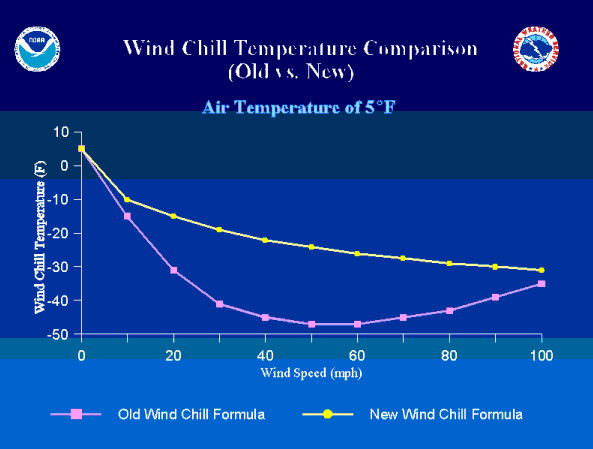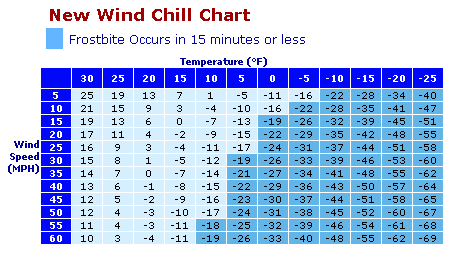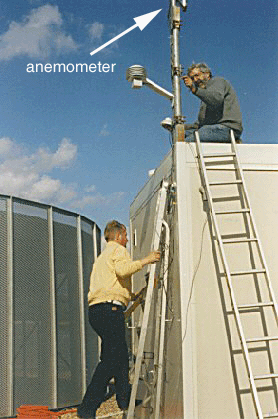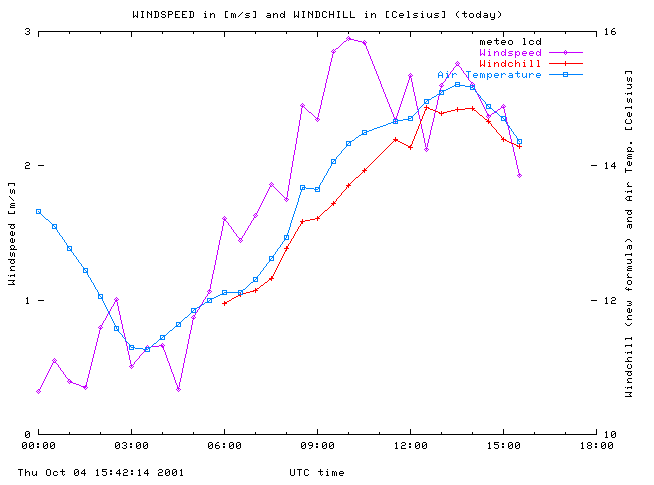A short explanation
Francis Massen
04 Oct 2001
newwindchill.html
version 1.2 updated 13 Oct 2001

| The new windchill
formula A short explanation Francis Massen 04 Oct 2001 newwindchill.html version 1.2 updated 13 Oct 2001 |
 |
| Abstract: Starting 03 October 2001 meteoLCD computes and displays the windchill together with windspeed and air temperature using the new formula accepted by the meteorological services of Canada and the USA. This paper gives some explanation on the old and new formulas, the problems of defining thermal stress levels and the caveats in interpreting the new windchill data. |
1. The old windchill formula
The bare human skin is normally covered by a thin layer of insulating moist air, in which the temperature falls from that on the skin surface down to the lower air temperature (we will exclusively consider this cold weather case). Moving air "blows" away more or less effectively this layer, removing heat from the body more effectively than still air. Increased evaporation of skin moisture (sweat) further lowers down the temperature of the skin surface, which may become noticeably colder than the ambiant air: this skin temperature is what the human body felts, so it sometimes is called the perceived or felt temperature (in German: "gefühlte Temperatur"); the term windchill (in French: "refroidissement éolien") however is commonly used throughout the world for this effect, and is displayed by many meteorological instruments or weatger stations. It is important to know this temperature in cold winter conditions, as the bare unprotected skin may rapidly freeze, develop a frostbite and die off. This can happen in less than 15 minutes under the relatively balmy conditions of -18°C and a wind blowing at 24 km/h.
During the 1940's two Antarctic explorers, Paul Siple and Charles Passel experimented with waterfilled plastic cylinders exposed to the outside, and noted the time for the water to freeze in function of air temperature and windspeed measured by a traditional meteorological anemometer, which is situated on a mast at 33 feet (about 10m) above ground. They developed the following formula for the windchill temperature (WCT), also called Sippel and Passel windchill index:
 |
where WCT and T are in °F and windspeed V in mph (miles per hour). In SI units ( T [°C] and V[m/s] ) this becomes (try it out...this is a useful exercice in unit conversion!):
|
|
It is obvious, that the WCT is meaningless for V=0; so it should be applied only above a certain threshold windspeed, usually 5 mph (~2.2 m/s).
2. The new formula
The above index has been in use for over 50 years in many countries of the world, despite the evident fact that the human face is quite different from a plastic cylinder, and that the wind speed at face-level (about 5 feet or 1.5m above ground) certainly is much lower than that on the high standard anemometer mast! So a debate was simmering (or even raging) between the scientific community for many years, wether this WCT really represented the cooled skin temperature, and if recommandations and restrictions taken according to its values were always meaningful.
In Germany, a school of scientists around Fanger disagreed nearly completely, and refused to accept the index. Instead, building on Fangers "comfort equation" (in German: "Behaglichkeitsgleichung") Jendritzky et al. developed a complicated model called "Klima-Michel" by calculating the total heat balance of the exposed human body, taking especially into account thermal transfers by radiation. This model than allowed to compute the perceived temperature, used by the German Meteorological Service (Deutscher Wetterdienst).
In Canada and the USA, dissatisfaction with the old WCT resulted in a cooperative work of the Meteorological Services of Canada (MSC), the US National Weather Service (NWS) and several other members of academic research to build a new scientifically sounder formula. Besides much mathematical modelling, real human experiment was also involved: "volunteers" were exposed, with temperature sensors attached to their face, to various windy and thermal conditions in a wind-tunnel. All this lead to a new windchill formula which is based on the following important assumptions:
Here is the new formula:
in US units (T[°F] and V[mph]):
which becomes in SI units (T[°C] and V[m/s]):
The following graph (courtesy noaa) shows that the differences between the old and new indices are starkling:

Is is astonishing that everybody relied for almost 50 years on a formula which deviates from the newer (assumed scientifically more correct!) by nearly 25 °F ( ~ 14 °C) at an air temperature of 5 °F!
Using the new WCT, frostbite will occur in less than 15 minutes according to the following table (courtesy kare11):

(time permitting, this will be transformed to SI units later on...)
Click here to find a more informative table on wind chill hazards by Environment Canada .
3. WCT computed and on display by meteoLCD
MeteoLCD anemometer(s) are fixed on a mast about 1.8m above the upper rim of the container housing the equipment, which itself sits on the roof of a building of the Lycée Classique Diekirch, 20m above groundlevel:

We decided to take (at least for the moment) for V10m what is measured by the anemometer (channel 9 of the logger); two plots have been added to the graph of the windspeed: air temperature and the new computed WCT. This will be shown ( in red color) only if wind velocity is higher then 1.4m, as seen from the next graph:

This decision required some tweaking of the Gnuplot command files to find an obscure, not well documented command to leave out data points ( test_condition ? function: 0/0 ); the 0/0 does the trick!
We hope that this new windchill plot will be of interest during the coming cold winter ( if global warming does not impede on this :-) ...); meteoLCD is the first station here in Luxembourg and probably in the neighbouring region to apply the new windchill formula, which hopefully will become a better accepted standard than the old one.
References:
| 1. | The
National Weather Service: National Weather Service plans to Implement
a New Wind Chill Temperature Index this Winter. NWS - Des Moines. This site also contains a WTC calculator, showing results given by old and new formulas |
| 2. | Jendritzky, Staiger, Bucher, Graetz, Laschewski (Deutscher Wetterdienst): The Perceived Temperature; the method of the Deutscher Wetterdienst for the Assessment of Cold Stress and Heat Load for the Human Body. (look for the .txt version, as the link to the .pdf file seems to be broken) |
| 3. | VDI-Richtlinien: Methoden zur human-biometeorologischen Bewertung von Klima und Lufthygiene für die Stadt- und Regionalplanung; Teil 1: Klima. VDI 3787 Blatt 2 |
| 4. | Davis Weather Club E-newsletter for October 2001 |
| 5. | Environment Canada: Wind Chill |
| 6. | kare11-weather: New Windchill Chart |
| 7. | Wind Chill Science and Equations (Environment Canada) |
windchill icon on top of page courtesy www.frostbitedays.com